#Pinyin
Explore tagged Tumblr posts
Text
documenting my journey to really actually making podfic! EDIT 12-FEB: 7 days One Month
EDIT: 10-MAR!!! TWO MONTHS Of Bedtime Stories & counting!!!
+++ i am contemplating making a podfic episode narrating thru my process from start thru posting to ao3. would there be an audience for this???+++
this post is gonna be an ongoing series of links (in the replies) for blog posts that inspired me to DO THE THING! it's like tracking what bits of tumblr i was interacting with almost in real time.
-----
EDIT: 2025.03.16--want to request a podfic ??? https://forms.gle/gAGQ4zap68qZ1kj3A
-----
EDIT: 2025.03.10--i've also been making updates of podfic resources and personal stories in the replies!
and! did you know about the tumblr podfic community??? https://www.tumblr.com/communities/podfic
-----
to everyone i reblogged and/or who replied to me: i just wanted to tell you that your post was part of the inspiration & motivation that led me to making & posting my very first podfics!!! tysvm!!!
==========
follow my podfic tag xk_s_reads !!!
what's possibly coming up next for recording??? 🔮 podfic teaser
==========
my self-aimed ao3 work notes / instruction guide so i remember how i do the podfic thing (CONSTANTLY UNDER REVISION lol)
==========
BABY'S FIRST AO3 POSTED WORK !!!
[podfic] Just One More by MaelstromOfEmotions
==========
baby's first podfic experiment
https://www.tumblr.com/xiaokuer-schmetterling/772445948782821376/hope-poem
==========
tyvm for the support & encouragement in chats
@ferntasie @maelstrom-of-emotions @travelingneuritis @keriarentikai @geck-motj
==========
ao3 resources
the list prev in this section compiled into the 'references' chapter of my podficcing notes to self/instruction guide: https://archiveofourown.org/works/62233522/chapters/160984369
==========
pinyin pronunciation resources
i took a semester of mandarin chinese in community college forever ago and this is something i found that is catchy and quirky and funny and memorable. it's part 1 of a 4 video playlist. actually really helpful if you pay attention to the shape of the mouse's mouth. the grouped consonants all have the same mouth shape with sequentially further back positioning of the tip of the tongue on the roof of your mouth fyi
youtube
this is a pinyin guide by user @pumpkinpaix and it has an accompanying transcript with tone markers and embedded audio!
https://pumpkinpaix.tumblr.com/post/619038202237452288/hello-cyan-you-have-the-cutest-voice-one-thing
==========
btw this is the image in my mind anytime i say I DID THE THING or similar


motivational art by @thelatestkate
=========
end post
#xk_s_reads#long post#my podfic journey#mdzs#ao3#ao3 resources#pinyin#🎧 process podfic#my ongoing podfic journal#📀 featurette#adventures in podficcing#podfic resource#podficcer resource#podfic
151 notes
·
View notes
Text
A List of "Beautiful" Chinese Words
for your next poem/story
Pinyin - English
Àn - dark
Ān quán - safe
Bēi cǎn - tragic
Dú tè - unique
Fàng sōng - relaxed
Hài xiū - shy
Huā shào - flowery
Jiāo - burnt
Jiāo ruò - delicate
Jīng diǎn - timeless
Jīng zhì - exquisite
Kǔ tián - bittersweet
Měi (lì) - beautiful
Méng lóng - misty, hazy
Mó hu - vague
Nài xīn - patient
Qí guài - strange
Róu hé - soft
Sī huá - silky
Tián - sweet
Xī yǒu - rare
Xiāng - fragrant, aromatic
Yǒu jià zhí - valuable
Yù - rich, strong
Zì xìn - confident
Hanyu pinyin
The phonetic symbols for Chinese characters.
The system to transcribe Mandarin Chinese sounds into a Latin alphabet.
It was invented in the 50s, and adopted officially in mainland China in 1958.
Pinyin is used for several purposes:
It can help learners of Chinese (including native speakers) to read Chinese characters and/or words.
To transcribe names and places into words accessible to Romanized language speakers, and it can be used as an input method for typing Chinese characters.
If any of these words make their way into your next poem/story, please tag me, or send me a link. I would love to read them!
Sources: 1 2 ⚜ More: Word Lists
#requested#chinese#pinyin#langblr#writeblr#language#linguistics#writing inspiration#dark academia#writing reference#spilled ink#writing ideas#creative writing#literature#writers on tumblr#light academia#poets on tumblr#writing prompt#words#lit#poetry#writing resources
92 notes
·
View notes
Text
Let's learn pinyin!
#xiaohongshu#xiaohongshu for you#rednote#xhs#best of xhs#china#chinese#best of rednote#best of xiaohongshu#language practice#chinese language#language learning#language#pinyin#pronounciation
27 notes
·
View notes
Note
I’ve wanted to learn mandarin for a while but the language feels really overwhelming. do you have any absolute beginner tips? also is learning to write/read pinyin a good starting point or should that wait till later?
Hi! Sorry for getting back a little late, I've been a bit busy!
I totally get how it feels really overwhelming because it genuinely can be at times! If you want to start, you don't start with learning characters and vocab, but learning pinyin and tones. Training your pronunciation and listening skills is so fundamental, so it is always the first thing anyone learning this language learns—even native speakers! Pinyin uses the alphabet and tone markers to express the sounds of the language. The way they are pronounced can be different than what you may be used to, so remember that it is just a guide and not a totally phonetic equivalent.
I really recommend this video series since it's free and very comprehensive. It also links to their pinyin chart which will give you every single pronunciation you could ever hear. Chinese pronunciation is very consistent, so you can learn every possible combination of sounds relatively easily! After you finish that, then move on to learning vocabulary and grammar like any other language.
If you specifically want to learn Taiwanese Mandarin, they do not use pinyin, but zhuyin. It works the same way and teaches the same sounds, but does not use the alphabet, but it's own system of symbols. I'd recommend learning both pinyin and zhuyin in that case. Here is a video series on Zhuyin!
It can be a lot to take in at the beginning, but you've got this!
加油!
39 notes
·
View notes
Text
youtube
my thought: don't prounce x in chinese as shee in english
290 notes
·
View notes
Text
So I've been playing around with Cāngjié…
And I thought a post like this (similar to a post on Zhùyīn done by linghxr) may be of interest to some.
Edited: 10 Sep 2023
This post has gotten a little popular lately and on scrutinizing my own post again, I've come to the conclusion that I had made some mistakes in my given character examples.
Amended now. Namely, 「唔」 and 「龍」 have now been swapped over in the examples.
「唔」 is really the “3-parts”, and 「龍」 is indeed a “2-parts” character! Amendments are reflected in orange.
What (and who) is Cāngjié?
For those who may not know, Cāngjié is another way to input 漢字/汉字 (Hànzì — Chinese characters). It is way less popular than Pinyin (or even Zhuyin) but it still has its fans, and has a few advantages over the other two.
Cāngjié is also the name of the mythical figure in Chinese legend who is said to have been the inventor of 漢字/汉字, for which Cāngjié (the input system) was named after.
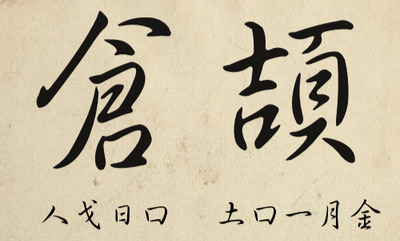
Would I recommend it?
Yes, if you think you have already acquired a good (enough) understanding of 漢字/汉字, and/or just like a new challenge.
(TL;DR at the end)
Why am I learning Cāngjié (and why you may like to, too)?
1. Mostly for fun.
Have long been intrigued by both Cāngjié and Zhùyīn, and since I finally mustered up the courage to tackle Zhùyīn not too long ago, I thought I'd finally give Cāngjié a try.
While learning Cāngjié does require more effort than learning Pinyin or Zhuyin, it can also be really fun! Inputting 漢字/汉字 with the Cāngjié method is almost like doing a jigsaw puzzle.
The euphoria derived from figuring out and piecing together the radicals that make up a word is something that learning Jyutping (Cantonese equivalent of Pinyin), Pinyin or Zhuyin can't quite match.
And while I know I'll never be as adept with Cāngjié — my knowledge of 漢字/汉字 is nowhere near good enough to ever use Cāngjié efficiently — as I do Jyutping or Pinyin (or to some extent, Zhuyin), it'll still be fun to use Cāngjié every once in a while!
2. Helps with thinking and typing in Chinese.
The upshot of relying too much on using Jyutping/Pinyin/Zhuyin is, I'd tend to think in Roman letters or ㄅㄆㄇㄈ before I'd even think about the actual 漢字/汉字.
But with Cāngjié, because it's based on knowing radicals and joining them together to form actual characters, it'll encourage thinking of 漢字/汉字 first, so I think that would help some with 漢字/汉字 memory retention.
Now you may be thinking, why not just you know, practise actually writing then? That is the tried and proven method to better remember 漢字/汉字 after all?
Yes, of course I can do that — and am doing so occasionally — but we live in a digital age now, and the probability and opportunity to type things out is much higher than actually writing stuff by hand.
The idea here is, more looking to think of and envision characters fully in my head, and trying to lessen over-reliance on Jyutping/Pinyin/Zhuyin.
And this is where I find Cāngjié can be useful, which leads to my next point…
3. Haunted by “What if” scenario.
What if there comes a day (however improbable) where I'm presented with only a Cāngjié keyboard to use for typing Chinese? It has happened with Zhùyīn for me!
That means, no Pinyin or Zhuyin keyboards, no Handwriting tools/touchscreens to write with fingers/mouse, no speech-to-text, and no option to copy-and-paste characters from somewhere else either! What then?
4. Able to type without knowing pronunciation, and with more accuracy.
Cāngjié is shape-based. Unlike Jyutping/Pinyin/Zhuyin, where you have to know what a character sounds like before you can type it out, with Cāngjié, you can type out (again assuming no Handwriting or other tools available) characters without needing to know how to pronounce them at all.
With shape-based typing, you'd also get more accurate hits in the first few 漢字/汉字 that show up, versus sound-based methods like Pinyin where for e.g., typing out “wan” will get you a whole list under the same sound and you may have to scroll through a whole lot to get the exact “wan” you need.
You can also type both Traditional and Simplified characters without having to toggle something or switch keyboards.
So how does one begin learning Cāngjié?
Install a Cāngjié keyboard.
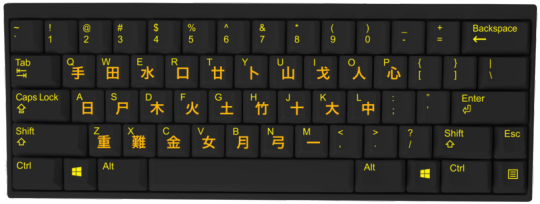
Duh…but of course! Heh! Gboard offers one, banded under Cantonese language input (Android user here, don't know about iPhones, sorry).
There are two versions of Cāngjié that are prevalent currently. Cāngjié 3 and Cāngjié 5. Cāngjié 5 is supposed to be an improvement over version 3 but I don't find there's much; having a slightly altered version just adds to the confusion and unnecessarily complicates matters, in fact!
If you have a choice, I'd recommend selecting Cāngjié 3 as that is more supported. Some operating systems may not be too compatible with Cāngjié 5 still, for some strange reason.


You may also come across something called “Quick” (速成) aka, “Simplified Cāngjié”.
This is simply a scaled down version of Cāngjié, it's still based on Cāngjié's formula. So you still need to know how Cāngjié works in order to use “Quick” efficiently.
You'd then need a chart like this. ↓
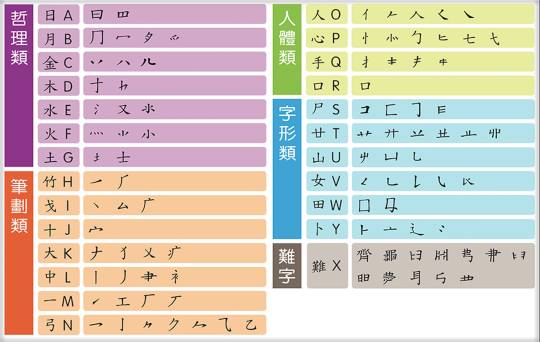
* the 重 (Z) key doesn't really come into use. I don't really know what it's for, but it seems to be used (paired with other keystrokes) mainly to type out various punctuation marks.
There are variants out there, some having a little more, or less, radicals shown than in the above example, but I'll say the chart here is one of the more comprehensive ones I've found so far (and sufficient enough) — other charts often fail to highlight the 難 (X) key and what it corresponds to.
You don't have to memorize the chart all at once. Just always have a chart like this on hand to refer to and with enough typing practise, you'll eventually remember which key corresponds with which radicals.
Remember the rules. ↓
“1 part” character (e.g. 寫) = first 3 & last (radical).
“2 parts” character (e.g. 唔龍) = first & last, first 2 & last.
“3 parts” character (e.g. 難) = first & last, first & last, last.
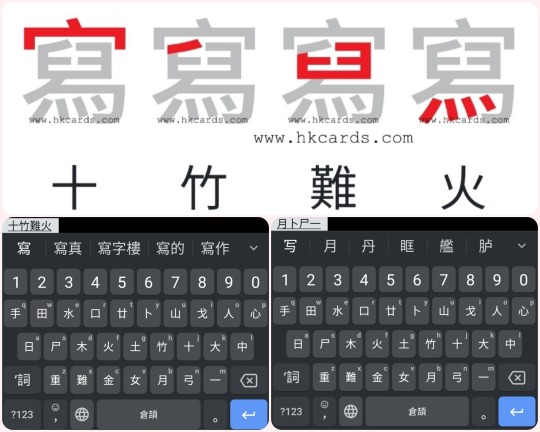
e.g. 寫 ↓
With radicals 宀,丿,臼 (first 3) and 灬 (last).
Corresponding keys: 十,竹,難 and 火。
寫 → 写 ↓
With radicals 冖,卜,㇆ (first 3),一 (last).
Corresponding keys:月,卜,尸 and 一。
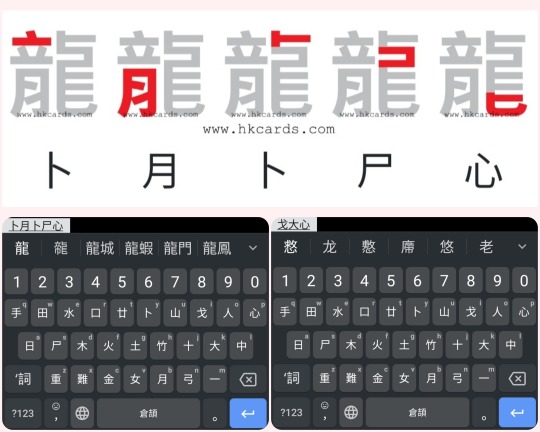
e.g. 龍 ↓
With radicals 亠,月 (first & last), 卜,コ (first 2),ヒ (last).
Corresponding keys: 卜,月,卜,尸,and 心。
龍 → 龙 ↓ (Simplified 龍 → 龙,a “1 part” character)
With radicals 丶,ナ,ヒ (first 3).
Corresponding keys: 戈,大,and 心。
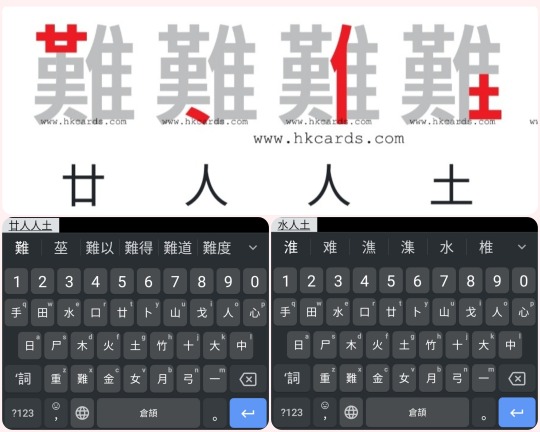
e.g. 難 ↓
With radicals 廿,人 (first & last),亻(first & last),土 (last).
Corresponding keys: 廿,人,人 and 土。
難 → 难 ↓
With radicals ヌ (first & last),亻(first & last),土 (last).
Corresponding keys: 水,人,and 土。
Occasionally, you may get a character that looks like a “2 parts” but is actually a “3 parts”. ↓

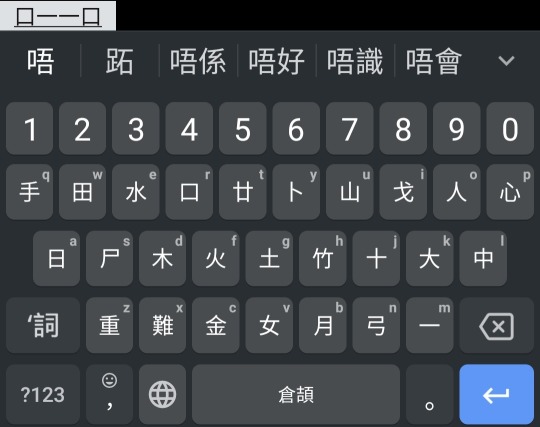
e.g. 唔 ↓
With radicals 口 (first & last),一,一 (first & last),口 (last).
Corresponding keys: 口,一,一 and 口。
Or looks like a “1 part” but really a “3 parts”. ↓
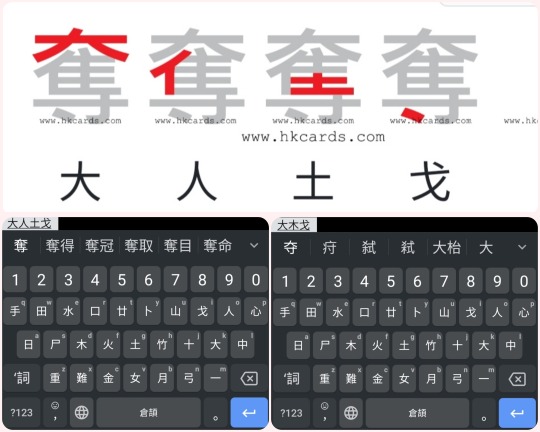
e.g. 奪 ↓
With radicals 大 (first & last),亻,土 (first & last),丶 (last).
Corresponding keys: 大,人,土,and 戈。
奪 → 夺 ↓(Simplified 奪 → 夺,a “1 part” character)
With radicals 大,寸 (first 3; the 丶 is the 3rd component).
Corresponding keys: 大,木,and 戈。
But these are exceptions, and don't occur that often.
And you can start practising!
You can try out this pretty good app called 『五色學倉頡』 (learning Cāngjié with 5 colours), for practise. It's on Playstore, just search for “Cangjie Dictionary” and it should show up.
You have to pay to unlock higher levels, unfortunately. ↓


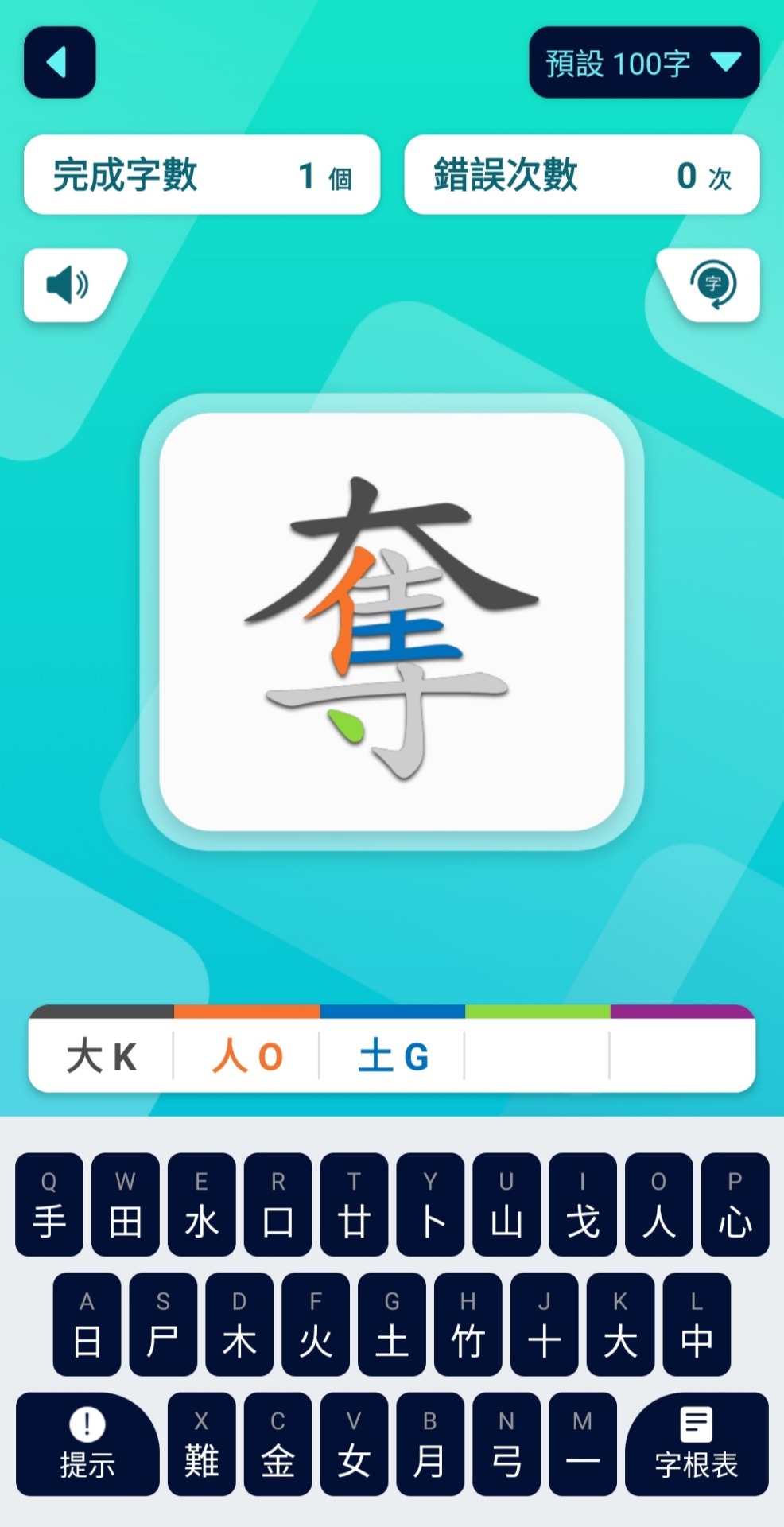
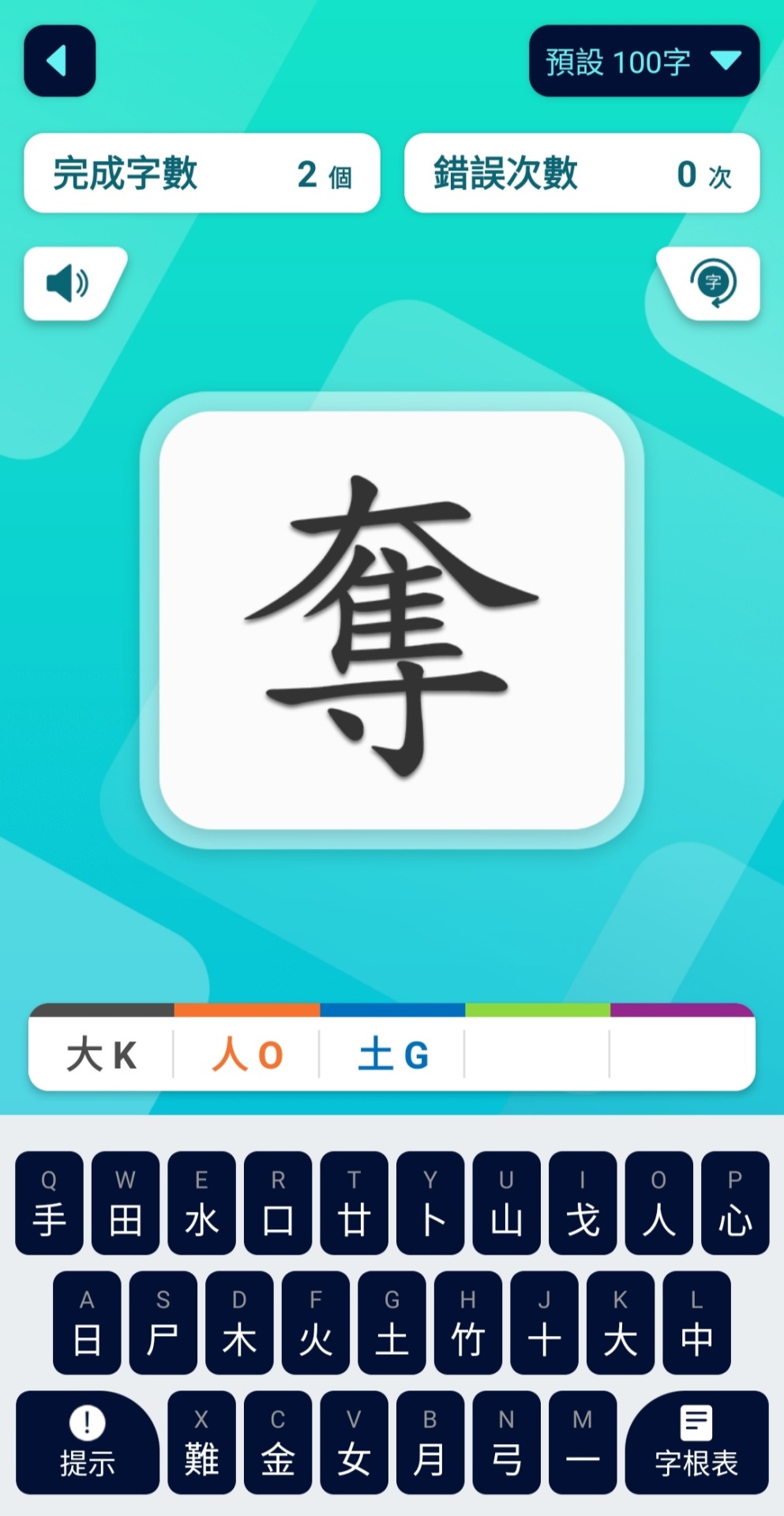
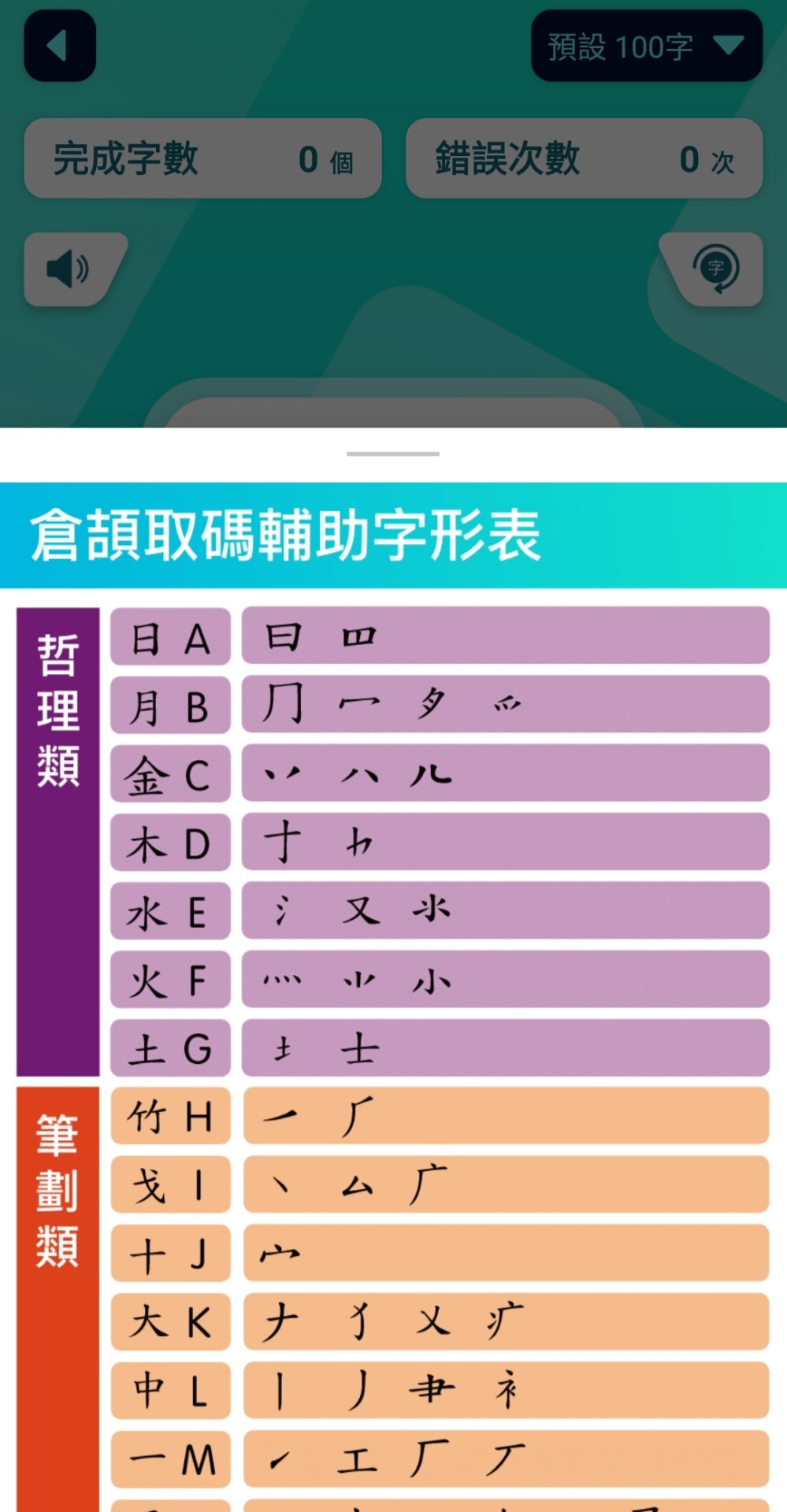
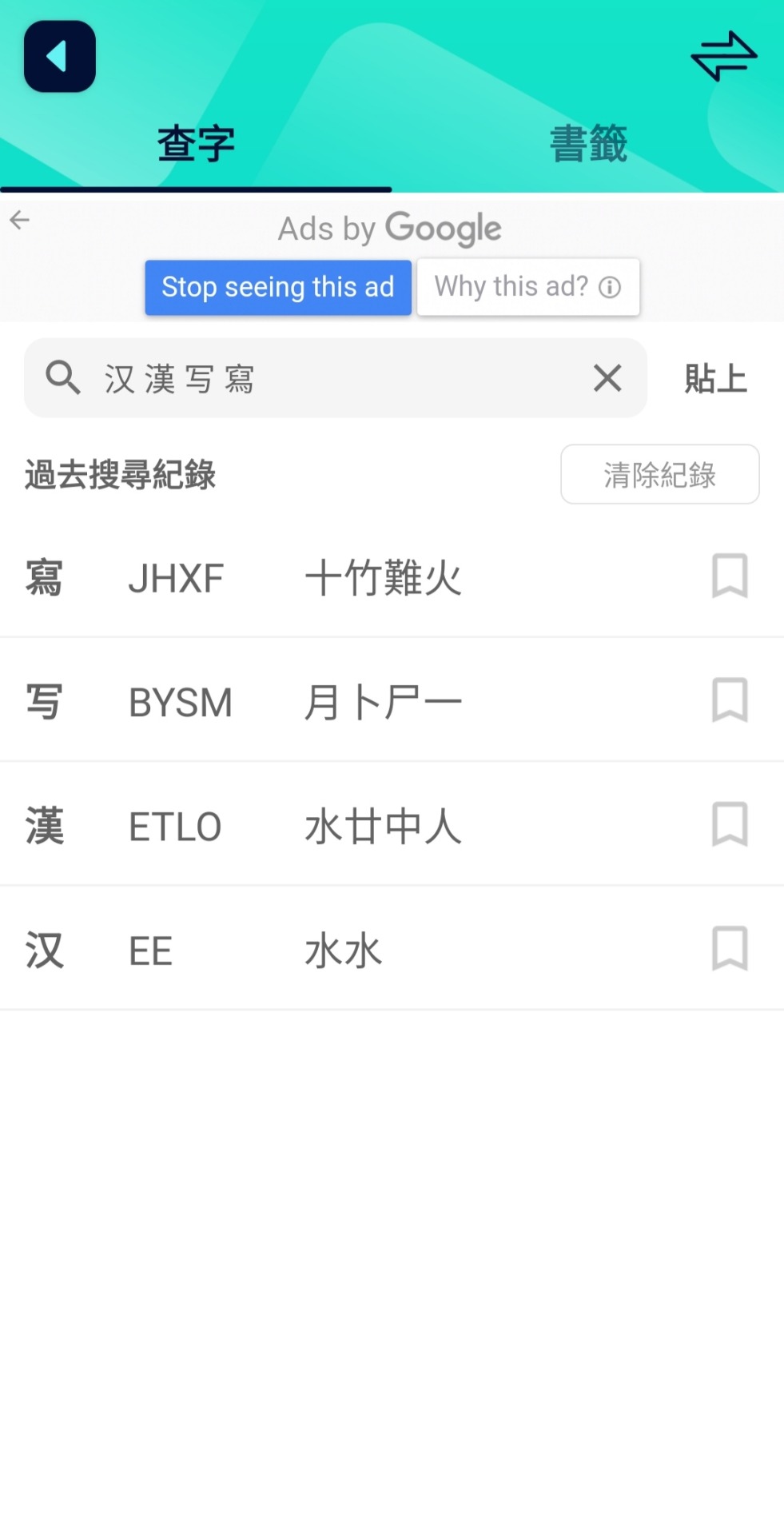
Anyway, each character comes with colour coded hints and you can opt to turn them off if you like more of a challenge. There are also hints (提示) and the chart (字根表) to refer to if you're really stuck. Also has a dictionary component (查字典) to check out the Cāngjié input for characters.
Another option would be a website called HKCards. ↓

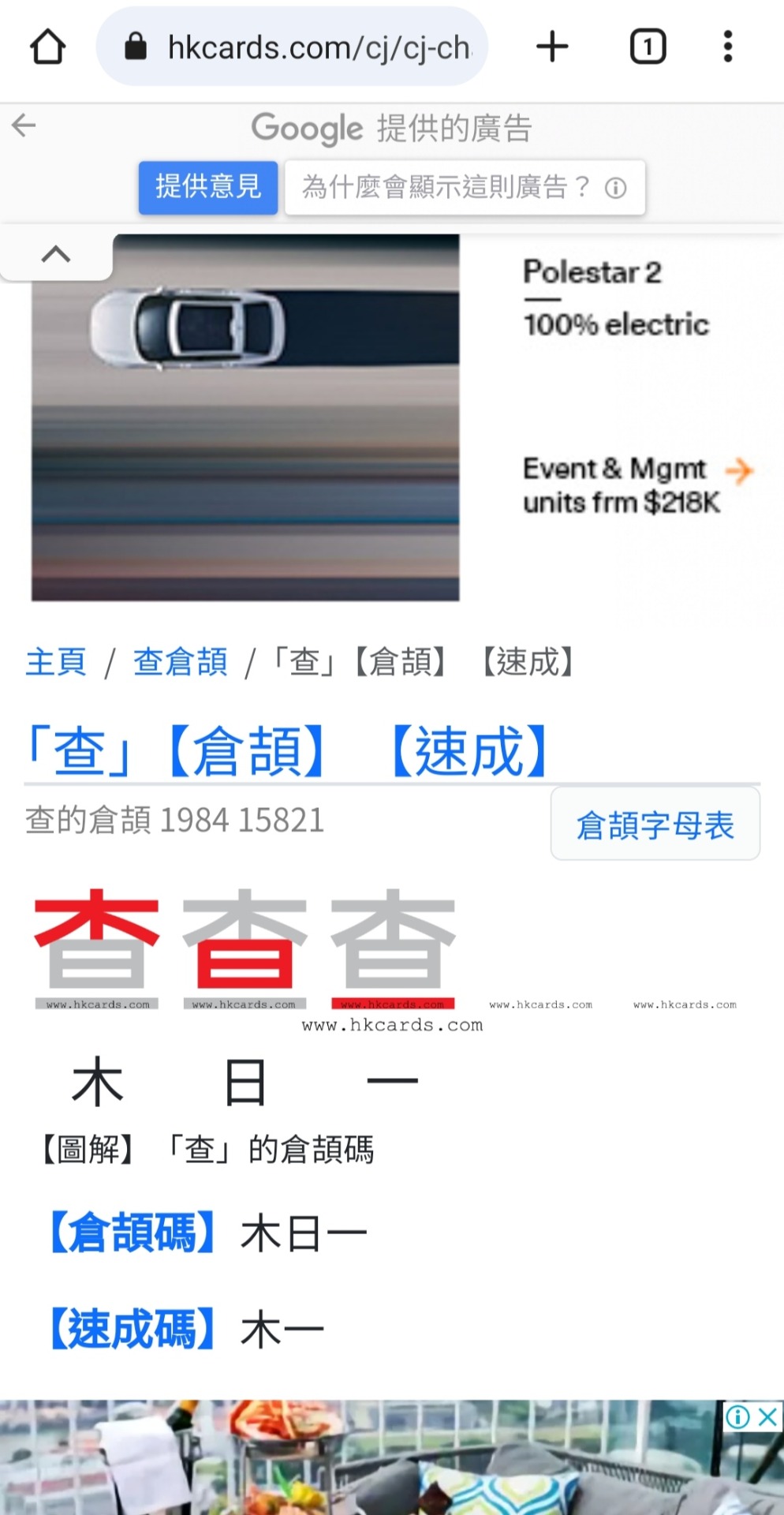
You can use it to check the Cāngjié input for any 漢字/汉字, and there's section for practise (倉頡輸入法練習) as well. After inputting your answer with Cāngjié keys (手田水口廿卜), you can click on the “Answer” (答案) button to see how right or wrong your answers were. ↓

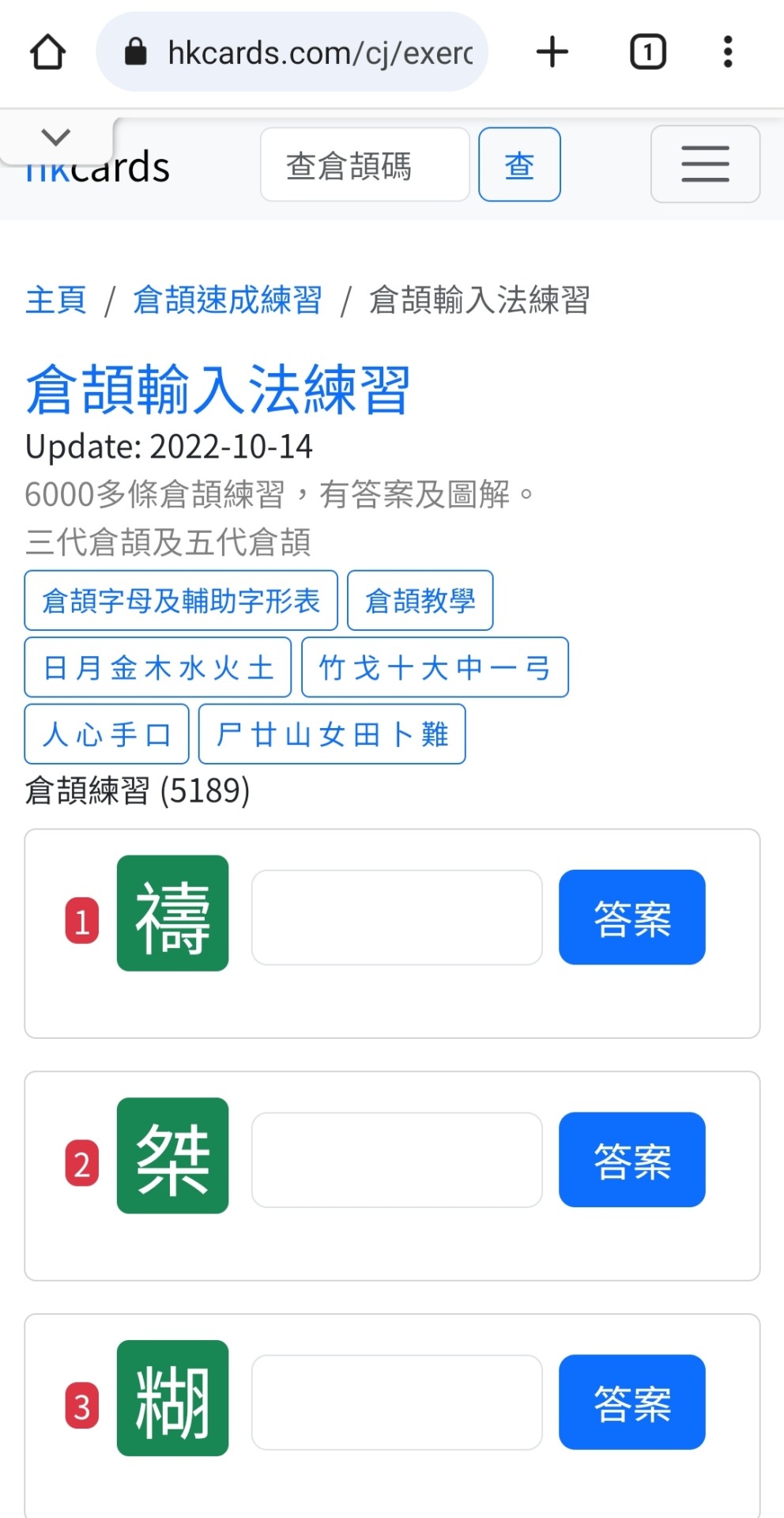
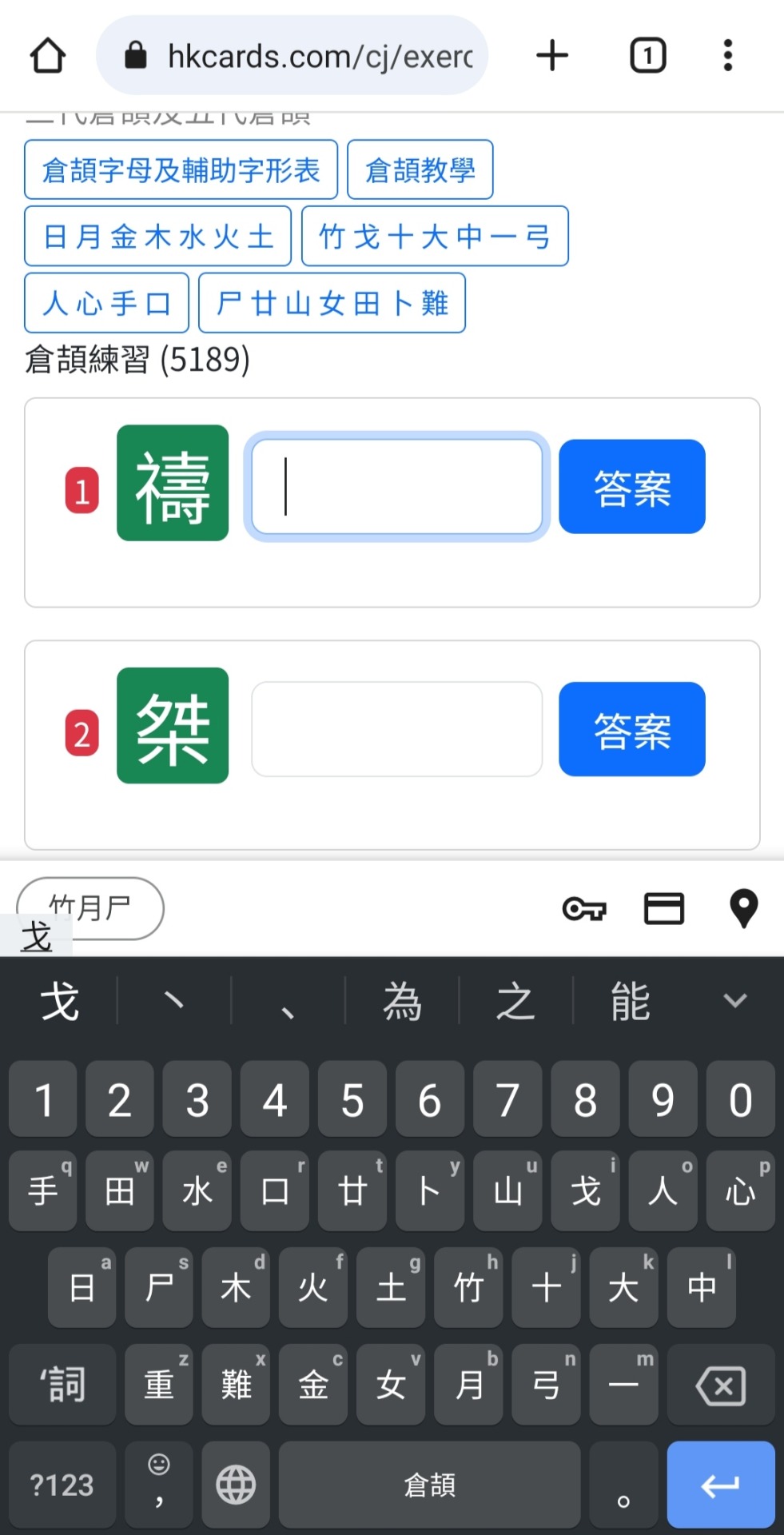

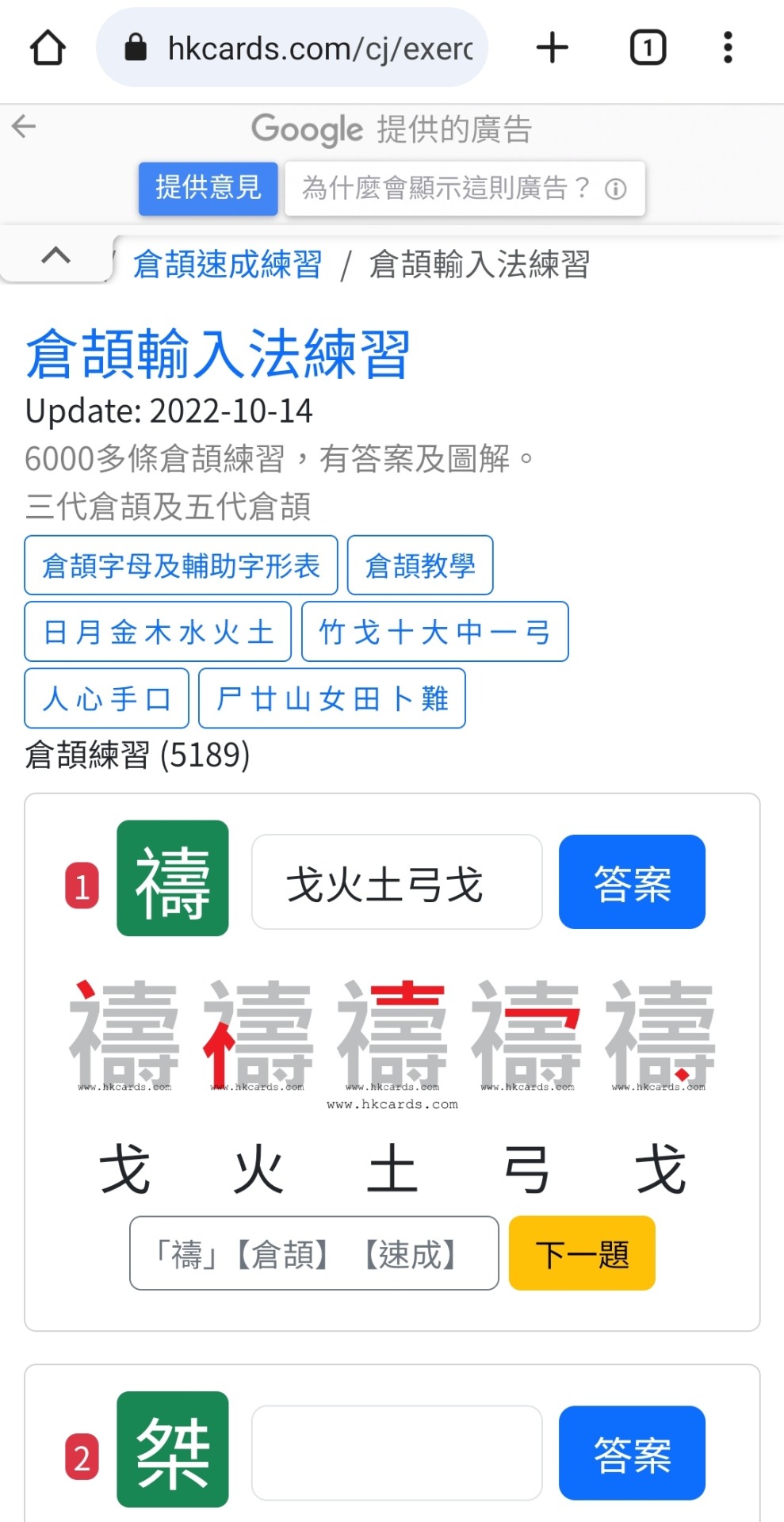
There are 8 characters each time, and you can just hit “Practise Again” (再做練習) to refresh for another 8 to practise with. I've yet to hit a limit.
Unfortunately, this website has lots of ads popping up. And it only supports searching in Traditional characters (Cāngjié was initially catered more for Traditional).
Or you can just try practising randomly with a Cāngjié keyboard and check for mistakes with a Cāngjié dictionary (『五色學倉頡』 app's dictionary comes in really useful here — it appears to support searching in Simplified too).
TL;DR
Cāngjié could be useful (and fun) to know if your 漢字/汉字 knowledge is already adequate, and/or you just like a new challenge.
And if watching videos is more your thing, here's a really helpful YouTube tutorial on how to use Cāngjié (has English subs)!
#Cangjie#Congkit#Cantonese#Mandarin#Jyutping#Pinyin#Zhuyin#Bopomofo#Traditional Characters#Chinese Language#Language#Long Post#Dake Rambles
266 notes
·
View notes
Text

#yin_yang#阴阳#concept#pinyin#taoism#yīnyáng#forces#http://aabon35.blogspot.com ⚫️ http://arubio28814.blogspot.com#complementary#x#tiktokersleaks#ai#literally#interconnected#chinese#tiktoklive#ia#dark#bright#universe#geminis#philosophy#interior#tiktok#opposite
27 notes
·
View notes
Text
in like svsss fanfictions when characters refer to themselves as 'this one' what exactly are they saying? Like the hanzi, the pinyin, etc.
#chinese language#learning chinese#learning languages#languages#learning mandarin#foreign languages#Chinese#mandarin#mandarin langblr#hanzi#pinyin#help#svsss#svsss fandom#svsss fanfiction#moshang#luo binghe#shen qingqiu#shen jiu#scum villian self saving system#scum villain
95 notes
·
View notes
Text
Working on focused listening skills again, because haha despite confidence when I did the tone pair drills on dong-chinese.com I got 40% (I seem to be confusing 1-1 and 1-2, 2-2, along with 3-2 and 2-2, and 4-4 I sometimes think is 1-1). So I need to do more differentiation practice. I used to score 90%+
Dong-Chinese.com Tone Trainer (I used this in the past)
Maorma.net Minimal Pair Test (I used this in the past, focusing on minimal pairs might help?)
Yoyo Chinese Tone Pairs Chart (may help)
Yoyo Pinyin Chart (has sound for each tone, this may help)
#tones#tone trainer#listening resources#chinese listening resources#chinese resources#pinyin#tones resources#chinese referencs#tone pairs#id like to be optimistic and think i can Hear the difference between words with different tones i just cant accurately identify which tones#im hearing... but telling the difference between 2 words is not enough to eventually Say them correctly if im wrongly guessing their tones
7 notes
·
View notes
Text
Islamic Holidays in Chinese
• Ramadan - 斋月 - zhāi yuè
• Ramadan Mubarak - 斋月快乐 - zhāi yuè kuài lè
• Eid Al-Fitr - 肉孜节 - Ròu zī jié
• Eid Al-Fitr (Ningxia Region Mandarin) - 开斋节 - kāi zhāi jié
• Eid Al-Adha - 古尔邦节 - gǔ ěr bāng jié
If you would like to greet someone Happy Eid, just add 快乐 (kuài lè) at the end of the sentence.
33 notes
·
View notes
Text
podficcer resource!!!
youtube
#xiran jay zhao#pinyin#mandarin#chinese names#pronunciation#pronunciation tips#🎧 process podfic#Youtube#podficcer resource
14 notes
·
View notes
Text
Heaven Official’s Blessing (天官赐福) Audio Drama Season 2 Theme Song - “Unenlightened” 《不悟/Bu Wu》 (Hanzi/Pinyin/English) Lyrics & English Translation
✲ Heaven Official’s Blessing (天官赐福/Tian Guan Ci Fu) Audio Drama Season 2 Theme Song
✲ Singer: Zhang Endai (张恩岱)
✲ Singer: 陈张太康 (Taikang Version)
Youtube Music Lyric Video (Original): here
Youtube Music Lyric Video (Taikang Version): here

•Original work: Heaven Official’s Blessing《天官赐福/Tian Guan Ci Fu》by Mo Xiang Tong Xiu (墨香铜臭)
♫Production Group♫
📌Original Production Team ℗ 2024 猫耳FM:
•Planning: Gua Hao Jun (括号君)
•Music Supervisor: Li Dabai (李大白)
•Lyrics: Ze Xing (择荇)
•Composition: Litterzy
•Arrangement: Xiang Wang (向往)
•Singer: Zhang Endai (张恩岱)
•Mixing: CuTTleFiSh
•Guitar: Xiang Wang (向往)
•Backing Vocal: 阿书Veson
•Art: 绘享视界ARThorizon
•Video: 699Studio@反卷文化
•Coordination:Yu Chen (鱼宸)
✲ Released on: 2024-06-22
——————————————
Lyrics:
Verse 1:
允许我成为,
yǔnxǔ wǒ chéngwéi,
无名的魑魅,
wúmíng de chīmèi,
或做你掌内
huò zuò nǐ zhǎng nèi
一捧灰。
yī pěng huī
就如我曾在,
jiù rú wǒ céng zài,
人潮中下坠,
réncháo zhòng xiàzhuì,
坠向你眷顾
zhuì xiàng nǐ juàngù
的轮回。
de lúnhuí
Pre-chorus 1:
天地鼎沸铜炉,
tiāndì dǐngfèi tóng lú,
剩我百炼荣枯,
shèng wǒ bǎi liàn róng kū,
不肯被
bù kěn bèi
血与泪宽恕,
xuè yǔ lèi kuānshù,
座下芸芸信徒,
zuò xià yúnyún xìntú,
而我冥顽不悟,
ér wǒ míngwán bù wù,
你才是唯一的救赎。
nǐ cái shì wéiyī de jiùshú.
Chorus:
万神在���,
wàn shén zài tiān,
不必垂怜,
bùbì chuí lián,
我要逾山越海相见。
wǒ yào yú shānyuè hǎi xiàng jiàn.
若你爱恋,
ruò nǐ àiliàn,
如斯璀璨人间,
rú sī cuǐcàn rénjiān,
请信我从未走远。
qǐng xìn wǒ cóng wèi zǒu yuǎn.
Verse 2:
允许我追随,
yǔnxǔ wǒ zhuīsuí,
有你的欢悲,
yǒu nǐ de huān bēi,
重逢在满城
chóngféng zài mǎn chéng
尽芳菲。
jǐn fāngfēi.
Pre-chorus 2:
有人匍匐白骨,
yǒurén púfú báigǔ,
有人端坐高窟,
yǒurén duān zuò gāo kū,
不肯将花与剑辜负。
bù kěn jiāng huā yǔ jiàn gūfù.
世上苦厄命途,
shìshàng kǔ è mìngtú,
为我惊心灼目,
wèi wǒ jīng xīn zhuó mù,
要渡你,
yào dù nǐ,
最无边忧怖。
zuì wúbiān yōu bù.
Chorus 2:
万神在天,
wàn shén zài tiān,
不必垂怜,
bùbì chuí lián,
痴者赴汤蹈火相见。
chī zhě fù tāng dǎo huǒ xiāng jiàn.
若你爱恋,
ruò nǐ àiliàn,
如斯璀璨人间,
rú sī cuǐcàn rénjiān,
请信我从未走远。
qǐng xìn wǒ cóng wèi zǒu yuǎn.
Last Chorus:
诸神不言,
zhū shén bù yán,
千秋万殿 ,
qiānqiū wàn diàn,
证你长行得偿所愿。
zhèng nǐ cháng xíng dé cháng suǒ yuàn.
若我奔赴,
ruò wǒ bēnfù,
如斯璀璨人间,
rú sī cuǐcàn rénjiān,
请等我回你身边。
qǐng děng wǒ huí nǐ shēnbiān
——————————————
English Translation:
Verse 1:
Allow me to be a “nameless” ghost[1],
or a handful of ashes in your palm.
Just like I, who once have slumped into the tide of crowd,
Falling into the reincarnation cycle of your favor.
Pre-chorus 1:
The world is like a boiling furnace over Tonglu,
leaving me to face the hundred trials of refine and misfortunes,
Yet I refuse to be forgiven by blood and tears.
There are myriad believers beneath the throne, however, I am adamantly unenlightened;
As you are my only salvation.
Chorus 1:
Gods in heaven; no need to show mercy!
I will cross over the mountains and seas to meet you
If you love this beautifully brilliant world,
Please believe that I have never gone far.
Verse 2:
Allow me to follow along with your joys and sorrows,
Then be reunited in the city of flowers.[2]
Pre-chorus 2:
Someone crawled over the bones of deceased people, someone sat in the cave,
Yet I refuse to forsake all the flowers and swords.
All the anguish and bitter destiny of the world have left the heart shocked, burning with horrors,
I want to save you even from the most boundless sorrows!
Chorus 2:
Gods in heaven, no need to show mercy!
This fool will go through all calamities to meet his fated one.[3]
If you love this beautifully brilliant world,
Please believe that I have never gone far.
Last Chorus:
The gods do not speak a word, but the thousands of years and the thousands of palaces,
are witnesses to the achieved desires of your long journey.
If I ran across such a beautifully brilliant world,
Please wait for me to come back to your side.
——————————————
Notes:
The title is "Unaware", but I follow the English subtitle in the original audio drama: "Unenlightened"
Allow me to be a “nameless” ghost[1],
Reunited in the city of flowers.[2]
This fool will go through all calamities to meet his fated one.[3]
[1]: Nameless is “Wuming” in Chinese
[2]: Hua Cheng also means “flower city”
[3]: Through fire and water = all dangers and difficulties. I interpret it as calamities.
——————————————
Don't forget to check the Youtube Music Lyric video:
Youtube Music Lyric Video (Original): here
Youtube Music Lyric Video (Taikang Version): here
——————————————
Thank you for reading. Have a good day! ✨
Please feel free to tell me if you have any questions, or if you notice any mistakes-- whether they be the vocabulary, grammar or something else.
Navigation: ✤ For translations, here. ✤ For more discussions and perspectives, here. ✤ For meme, here! If you like my writing, please consider giving me a tip through Ko-fi! 😊 ✤ More information (commission, messages, requests): Carrd
#天官赐福#tgcf#tianguancifu#heavenofficialsblessing#moxiangtongxiu#HuaCheng#XieLian#HuaLian#cultivation#xianxia#墨香铜臭#MXTX#Music#Lyrics#EnglishTranslation#Danmei#Novel#hanzi#english#romaji#Lyric#LyricVideo#translation#engsubs#subtitle#engsub#pinyin#drama#audiodrama#themesong
9 notes
·
View notes
Text
Does anyone know of an app that can translate hanzi into pinyin? Or even just read a text in hanzi out to me? I'm not looking for a translation, that doesn't help me understand the individual character. Google and pleco are only helpful when you can copy/paste the hanzi in, but I'm trying to read from magazines/books and every time I run into a character I don't know, I need ten minutes to figure out what the hell it is with that pleco puzzle thingy or trying to draw it (which never works because I don't know the stroke order). I get so frustrated with it, surely I'm not the only one struggling?
Somebody help please. Thank you.
7 notes
·
View notes
Text

💔📉😂 If your boyfriend is emotionally stable today and even strangely happy, break up with him immediately — he clearly holds no financial assets. He’s broke. // Jīn tiān rú guǒ nǐ de nán péng yǒu qíng xù wěn dìng, shèn zhì hái yǒu xiē mò míng kāi xīn, qǐng gǎn kuài fēn shǒu, yīn wèi tā méi yǒu chí yǒu rèn hé jīn róng zī chǎn, sh�� gè qióng bī.
Check out Vietnamese and Chinese versions: https://ngocnga.net/breakup/?utm_source=tumblr&utm_medium=social&utm_campaign=quote
#1quotein3languages#chinesequotes#dailychinese#chinesewords#putonghua#weibo#pinyin#quote#breakup#finance#redflag
2 notes
·
View notes
Text
It’s… strange. I type Chinese names in pinyin since I type in English most of the time, but the more pinyin I type the more I forget about the meaning of the name
Before I switched to Mandarin subtitles, I didn’t know which hanzi Zhongli’s name uses so I thought his name was written as 重礼 (roughly respectful etiquette or grand/solemn ceremony depending on context) and thought he was a very devoted mortal to some sort of deity
So when I learned it’s actually 钟离 and that he’s a god, it suddenly became even more sad… (the etymology section of his lore page on the wiki discusses allusions in his name), because though I couldn’t quite tell exactly what his name alluded to, I recognize 钟 that meant bell (along with some other things) and 离 is departure.
(Same 离 character as 归离原, the Chinese name for Guili Plains. Of course, making it “Field of Returning and Departure”)
39 notes
·
View notes
Text

As a Cangjie (倉頡) advocator…😻 (per Pleco, 齾 means “gap-toothed”, “chipped”, “dented” or “toothless” by the way, and is pronounced ngaa³ in 🇭🇰🇲🇴 Cantonese. “yà” is 🀄 Mandarin.)
#Saw this on the r/Cantonese Reddit thread#Cangjie#Congkit#Pinyin#Cantonese#Mandarin#Chinese Language#Language#Memes#Humour
13 notes
·
View notes